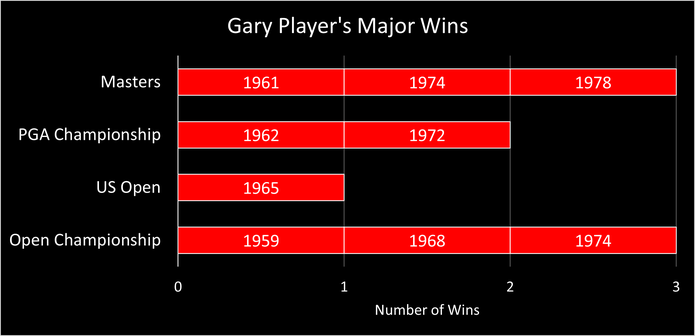 In many non-team sports, the pinnacle is winning the various major tournaments that take place each year.
In many non-team sports, the pinnacle is winning the various major tournaments that take place each year.
Pub quiz fans may know already that 18 individuals (eight men, ten women) have completed the career grand slam of majors in tennis: that is, winning the Australian Open, French Open, U.S. Open and Wimbledon singles titles (there is a doubles career grand slam too).
There’s a chance to win four majors each year in men’s golf too, with The Masters, PGA Championship, U.S. Open and Open Championship all part of the holy quartet.
Rory McIlroy missed the chance to complete his career grand slam at Augusta National in April, and while he’s still relatively young there will surely be a nagging feeling of incompleteness until the Irishman has captured the famous green jacket.
Each year, the PGA Championship presents Jordan Spieth with a chance to complete the full set of majors. While a wrist injury may scupper his chances in 2023, he has years ahead of him to win the event – albeit only one opportunity per year to get it done.
It’s perhaps telling that no man has completed the career grand slam since Tiger Woods in 2000 – a marker, perhaps, of just how ultra-competitive the sport is these days. Of course, the likes of Scottie Scheffler and Jon Rahm may yet end their lengthy drought.
Other than Bobby Jones, who completed a variation on the career grand slam in the 1930s that comprised the U.S. Open, Open Championship, U.S. Amateur and the Amateur Championship, only five men since have got their hands on golf’s four most vaunted trophies.
Gene Sarazen (1922-1935)

Gene Sarazen straddled golf’s amateur and professional eras, and as such was able to complete the career grand slam as we know it today – albeit over a span of 13 years.
He won the U.S. Open and PGA Championship in 1922, but would have to wait a decade before he could get his hands on the Claret Jug.
And in 1935, Sarazen was responsible for one of the most famous moments in golf – the ‘shot heard around the world’. His albatross on the 15th hole at Augusta in 1935, which came at a time when the feat was even rarer than it is today, saw him turn a three-shot deficit to Craig Jones into a tie for the lead.
The Squire, as he was known, would then complete a remarkable play-off victory over Jones to complete his career grand slam with The Masters.
Ben Hogan (1946-1953)

One of the difficulties, you suspect, of completing the career grand slam is the weight of expectation when you have three of the titles in the bag and then have to nervously wait for the opportunity to win the fourth to come around.
But Ben Hogan didn’t really need to worry about that as his major wins were fairly well spread out.
He captured the PGA Championship in 1946, the U.S. Open in 1948 and The Masters in 1951, before a wait of two years to complete the slam at the 1953 Open Championship at Carnoustie.
But boy, did Hogan have to make it count. That appearance was the only time he would play at the Open in his entire career, with difficult scheduling (the PGA Championship generally took precedence) and the difficulties of travelling to the UK by boat putting off Hogan and many of his American contemporaries.
Gary Player (1959-1965)

Playing in an era that also included Jack Nicklaus and Arnold Palmer to name just a few, the achievement of Gary Player to complete the career grand slam cannot be underestimated.
Nicklaus would win 18 majors and Palmer seven, albeit he would fall short of the grand slam despite three second-place finishes in the PGA Championship – the only major to elude him.
Unusually, Player’s first major win came at the Open Championship in 1959, before The Masters (1961) and the PGA Championship (1962) duly followed.
Like others in the grand slam gang, Player had to wait a while to complete his magical quartet – finally getting over the line at the 1965 U.S. Open at the Bellerive club in Missouri.
Jack Nicklaus (1962-1966)

Not content with completing his career grand slam, Jack Nicklaus went some way better than that and won all four majors at least three times each – cementing his legacy as arguably the greatest golfer of all time.
The ‘Golden Bear’ got his grand slam up and running with victory at the U.S. Open in 1962, and broke the back of his quartet a year later when he won The Masters and PGA Championship in a stellar 1963.
Like McIlroy and Spieth, Nicklaus had to put in the hard yards before he was able to complete the full set, but finally he got his hands on the Claret Jug in 1966 courtesy of a narrow one-shot victory at Muirfield.
All told, Nicklaus would win 18 majors – six Masters’, four U.S. Opens, three Open Championships and five PGA Championships – in a career that will surely never be matched.
Tiger Woods (1997-2000)

Tiger was the most recent inductee to the career grand slam club, taking just three years to secure his membership in an era in which he truly dominated the sport.
He was just 22-years-old when he tamed Augusta National for the first time to win The Masters in 1997, before adding the PGA Championship to his collection in 1999.
The Big Cat celebrated the new millennium by adding the U.S. Open and Open Championships to his collection – thus completing the career grand slam prior to his 25th birthday.
Tiger has won 15 majors so far in his career – including that infamous, Lazarus-like triumph at The Masters in 2019 following personal problems and a catalogue of major surgeries.